
Dedication of St Chad’s Cathedral
1.42k
 Saint Chad (d.672), a saint from Northumbria, is called the Apostle to the Midlands because he established his diocese at Lichfield in 669, and from there evangelized the kingdom of Mercia. The current Catholic successor to that ancient diocese is called the Archdiocese of Birmingham. This large diocese encompasses Oxford, hence today in the Dominican studentate at Blackfriars we celebrate the feast of the dedication of St Chad’s Cathedral, the diocesan cathedral in Birmingham.
Saint Chad (d.672), a saint from Northumbria, is called the Apostle to the Midlands because he established his diocese at Lichfield in 669, and from there evangelized the kingdom of Mercia. The current Catholic successor to that ancient diocese is called the Archdiocese of Birmingham. This large diocese encompasses Oxford, hence today in the Dominican studentate at Blackfriars we celebrate the feast of the dedication of St Chad’s Cathedral, the diocesan cathedral in Birmingham.According to the Ceremonial of Bishops, “the cathedral church is the church that is the site of the bishop’s cathedra or chair, the sign of his teaching office and pastoral power in the particular Church [i.e., diocese], and a sign also of the unity of believers in the faith that the bishop proclaims as shepherd of the Lord’s flock”. So, all the members of a diocese celebrate the feast of their cathedral’s dedication as a sign of filial piety, of their closeness to the bishop, and of their unity with one another in the faith. Moreover, the Ceremonial continues, “the diocesan cathedral ‘in the majesty of its building is a symbol of the spiritual temple that is built up in souls and is resplendent with the glory of divine grace … The cathedral, furthermore, should be regarded as the express image of Christ’s visible Church, praying, singing, and worshiping on earth. The cathedral should be regarded as the image of Christ’s Mystical Body, whose members are joined together in an organism of charity that is sustained by the outpouring of God’s gifts'”.
Hence, today we not only celebrate the physical building and what it stands for, but are also reminded of the spiritual reality which the building symbolizes, that we Christians are temples of the living God (2 Cor 6:16), and called to be living stones building up a spiritual house (1 Pet 2:5). For Christians, the church houses the Church, it is the domus Ecclesiæ in which we receive the sacraments of grace, and encounter the living God. From it we are sent forth into the world to proclaim the Gospel, and in it we receive refreshment and healing. Thus, at the time of St Chad, missionaries were sent to evangelize a local area from central churches that were generally called ‘Minsters’.
Because the church is the normative place where God is encountered in the sacraments, and in which the Altar of God is sheltered, and the Blessed Sacrament is reserved, the church building is also called the Domus Dei, the house of God (cf. Code of Canon Law, Can. 1220 §1), and these two aspects – House of God and House of the Church – form a unity in the one building. Sometimes one hears of a dichotomy being drawn between these two aspects, but that is not the Catholic way which is to be inclusive and encompass both aspects. Thus the liturgy of the dedication of a church emphasizes the sacral character of the church. For example, the Introit chant says: “How awesome this place is! This is the house of God and the gateway to heaven”, or (as we hear in the Gradual motet below), “This place is the work of God, a mystery surpassing all comprehension, above all reproach”. At the same time, Scripture readings (e.g. 1 Cor 3:9-17) remind us that we are called to be temples of God. For it is from such places of prayer, where we feed on the living Word and the living Bread, that we can grow in holiness, and so be effective disciples of Christ in the world. That great missionary St Chad knew this well, which is why he established churches and monasteries wherever he went, and it was from these places that saintly men and women were sent out to evangelize England.
In our time, mindful of the new evangelization called for by Blessed Pope John Paul II and Pope Benedict XVI, we do well to think of our diocesan cathedral. Consider what it stands for, but also consider the building itself. As bodily creatures, we need material places like church buildings. They are (or ought to be) places of beauty that enrich the local area, that lift the mind to God and refresh the world-weary soul, and that move the contemplative soul to long for heaven. The holiness of their beauty should move us to long for the beauty of holiness. They are places for evangelization as St Chad demonstrates.


